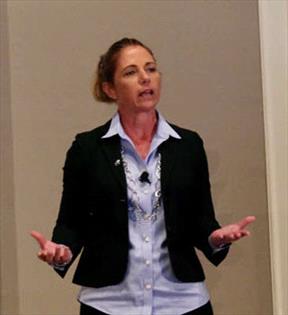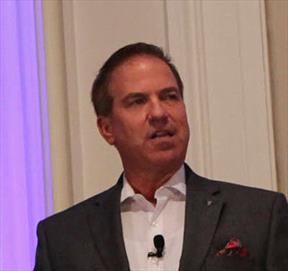Banfield, world's largest clinic chain, commits to elevating licensed support staff


Photo courtesy of Dj Cannon
Dj Cannon, a licensed veterinary technician, encourages veterinarians to develop, trust and rely on their veterinary technicians.
As a survivor of three corporate buyouts of independent veterinary practices, Dj Cannon decided 3½ years ago to join "the enemy." A licensed veterinary technician with a master's in public health and an experienced practice manager, Cannon took a job with the largest practice brand of all, Banfield Pet Hospital.
His thinking was, "I need to see what's going on over there."
What was going on didn't impress him at first. Working as a practice manager at a clinic in Fairfax, Virginia, Cannon found he no longer had the autonomy or creative challenges common to his previous jobs. He seriously considered leaving. Then, conditions improved. Cannon got a supportive new manager who allowed him more responsibility. Soon after, corporate leaders distinctly shifted direction.
In September, during its annual Pet Healthcare Industry Summit in Portland, Oregon, Banfield described a new focus on elevating veterinary technicians. Among the changes announced by Dr. Dan Aja, Banfield chief medical officer, are pay increases, expanded support for continuing education and professional development, and promoting opportunities for veterinary technicians "to work at the top of their license" — in other words, delegating certain medical tasks that in the past were handled by doctors.
"They are ... helping create an environment for technicians to grow in," Cannon said in an interview, noting that he feels more supported and heard. While he says the work to elevate technicians has just begun, he's "super excited" about the changes to date.
Many independent veterinary practices long have recognized the value of licensed technicians to the veterinary team but Banfield's actions have the potential to influence the profession because of its size. With more than 1,000 hospitals, Banfield is the largest veterinary practice brand in the world, employing more than 1,500 veterinary technicians in the U.S. Banfield is part of the international conglomerate Mars Inc., which owns three other practice brands in the U.S. and two in Europe.
"I think it’s noteworthy [that] Banfield is opening the conversation that veterinary technicians want to hear," said Charlotte Waack, a certified veterinary technician who directs the Veterinary Support Personnel Network, an online community for support staff. (VSPN is part of the Veterinary Information Network, an online community for veterinarians and parent of the VIN News Service.)
Aja did not say at the summit what motivated the shift in company philosophy toward support staff. In an interview by email afterward, he cited concern for the welfare of veterinarians and technicians but declined repeatedly to explain the timing of the new push.
The change coincides with the rise of a campaign called the Veterinary Nurse Initiative (VNI). Put forth by the National Association of Veterinary Technicians of America, the initiative aims to unite the profession under the title "Registered Veterinary Nurse" and standardize credentialing requirements and scope of practice in every state.
By doing so, advocates believe, licensed veterinary support staff will gain more overall recognition of their training and know-how, and better working conditions.

VIN News Service photo
Registered veterinary technician and co-chair of the Veterinary Nursing Initiative, Heather Prendergast talked at the Pet Healthcare Industry Summit about the challenges facing veterinary technicians.
Heather Prendergast, a registered veterinary technician and co-chair of the VNI, said awareness is increasingly broadly. "I think the entire veterinary field is looking at the veterinary technician profession to understand how to best support it and elevate it for the future," she said.
She cited multiple factors driving improvements, including low morale and high turnover among veterinary technicians; greater competition, in general, in a tight employment market; successful union drives by support staff at West Coast hospitals; and shortages of associate veterinarians.
Banfield’s new approach comes amid long-standing frustration among veterinary technicians with insufficient pay, lack of respect from employers and burnout, which, according to NAVTA, are driving credentialed support staff out of the profession and contributing to shortages.
In a survey by NAVTA in 2016, only 51 percent of veterinary technicians who responded reported feeling satisfied with their job. Fifty-six percent reported changing jobs within seven years, and of those, 45 percent left the field entirely.
Waack was shocked by the results. "It really hit hard," she said.
Explaining Banfield's desire to improve conditions for veterinary technicians, Aja told VIN News by email: "Veterinarians aren’t the only veterinary professionals who struggle with student debt, compassion fatigue and suicide. Veterinary technicians experience these challenges, and yet they are often left out of the discussion. For these reasons and many more, we believe there exists a great need to elevate veterinary technicians. They are core to the hospital team, and yet this profession isn’t a sustainable option for many."
Wages long have been a pain point for veterinary technicians. Those working full-time reported in the NAVTA survey average salaries between $15 and $20 per hour in 2016. Of respondents who left the profession, 38 percent listed low wages as the leading reason.
This year, Banfield increased hourly pay for its veterinary technicians across the board. Aja declined to say by how much but described the raises as designed to support veterinary technicians’ financial health and be competitive within each market.
"We have seen a substantial decrease in veterinary technician turnover since the pay raise went into effect," Aja told VIN News. The current annual turnover rate is 16 percent, he said, compared with 40 percent several years ago.
Among other new benefits, veterinary technicians receive paid subscriptions to an online continuing-education service, membership in NAVTA, and a chance to compete for financial support to attend national conferences.
Aja also said Banfield is focusing on having more veterinary technicians across its hospitals by providing tuition assistance to non-licensed Banfield employees who want to become credentialed technicians, as well as externships and paying for up to two sittings for the Veterinary Technician National Exam.
Working 'at the top of their license'
Last year, the company also internally adopted the term "veterinary professionals" to include veterinary technicians with veterinarians. Previously, technicians were in the same class as veterinary assistants. Now assistants are in a "paraprofessionals" category with client-service coordinators and practice managers.
Distinguishing between technicians and assistants is not rare. In a recent informal poll of VIN members, the vast majority of 1,687 respondents said they differentiate between credentialed and non-credentialed staff.

VIN News Service photo
Dr. Dan Aja, Banfield chief medical officer, told summit attendees that Banfield is "trying to drive a cultural shift" by elevating its veterinary technicians.
Banfield is making a further effort to encourage hospital leaders and veterinarians "to empower their veterinary technicians, so they feel enabled and encouraged to work at the top end of their license – within the confines of state veterinary practice acts, of course," Aja said. (Rules governing scope of practice and licensing for veterinary technicians are established in state practice acts, which vary greatly.)
Through discussions with veterinarians and other hospital leaders at Banfield and Mars sister veterinary practice brands; and reviewing state practice acts and the Committee on Veterinary Technician and Education and Activities’ skills list, Banfield identified 30 tasks that potentially could be handed over to credentialed veterinary technicians, Aja said. Examples are vaccination boosters, routine parasite prevention treatments and administering subcutaneous fluids — tasks that Banfield veterinarians previously handled.
Cannon, the veterinary technician in Virginia, said Banfield historically didn't have many credentialed support staff members at all, which makes the duty-shifting something of a cultural revolution.
"Because the doctors aren’t used to having technicians, they are really used to doing a lot on their own, or training assistants to do the things they can do within the law, but that puts a lot more pressure on the doctors," he said.
In his experience, people who have been with Banfield a long time don’t realize what technicians can bring to a practice. Changing their outlook requires a concerted effort to educate them on deploying technicians’ suite of skills, plus time to build trust. "[I]t really takes having technicians in place to be able to show doctors what we can do to help them," Cannon said.
Beyond Banfield, allowing credentialed veterinary technicians to play a central role is nothing new in many practices.
"I allow them to use their knowledge and skills to the extent the law will allow," Dr. Gary White, a practice owner in Southern California, said in a recent VIN message board discussion. "I can't remember the last time I injected, drew blood, placed a cath, took radiographs, etc. If it doesn't require my license, they do it."
White also said he offers his technicians the highest pay in the area and benefits that include health, dental, and life insurance, a 401K, a liberal CE budget and up to three weeks of paid vacation.
"I encourage them to keep current daily, and ask questions," he added. "We have some degree of professional conversations about medical and surgical decisions, treatments, etc., daily."
Dr. Cindy Barnes takes a similar approach. A veterinary technician for 15 years before obtaining a DVM and operating her own practice, she advocates delegating much of the operation to licensed support staff.
"The worst thing you can do with your technicians is micromanage them," said Barnes, former owner of an emergency hospital in Prescott, Arizona. "If you don’t trust your technicians, then you need to either check yourself or you need a new staff. You should trust your technicians with everything they are trained to do — that’s everything except physical exams, prescribing, surgery and diagnosis."
Barnes said that when she bought the hospital in Arizona, several veterinary technicians with whom she had worked in California relocated to join her. She increased their salaries, doubling some and offered profit-sharing.
"Practices that think they can’t afford to pay their technicians well don’t understand economics,” Barnes said, referring to the belief that increasing revenue requires adding a doctor or doctors in order to see more patients. “But reality is, if you are actually letting your technicians do everything they are trained to do … you [the doctor] can see more patients and generate better revenue."
She believes veterinary technicians are the answer to reported shortages of associate veterinarians. “We don’t have a shortage of veterinarians,” she maintains. "We have a shortage of technicians and under-education of veterinarians on how to use their staff to the greatest extent."
Barnes sold her practice in 2017 and now owns and operates a practice information management software company. She also works as a relief veterinarian.
Elsewhere at Mars
While Banfield works proactively to address veterinary technicians' concerns, two other Mars entities — VCA Animal Hospitals and BluePearl — are processing veterinary technicians’ dissatisfaction a different way.
With more than 850 facilities in the U.S. and Canada, VCA is the second largest veterinary practice brand in the world. BluePearl is a chain of emergency and specialty veterinary hospitals with 70 locations in the U.S.
Citing problems including lack of respect, overwork and poor salaries, support staff at one BluePearl and two VCA hospitals on the West Coast voted to unionize this year. In April, veterinary technicians, assistants, maintenance personnel and customer service representatives at VCA San Francisco Veterinary Specialists voted to join the International Longshore and Warehouse Union (ILWU). In September, workers rallied to protest VCA’s unwillingness to come to the bargaining table.
In May, support staff at BluePearl in North Seattle voted to join the National Veterinary Professionals Union (NVPU), a first-ever union for veterinary support staff. Collective bargaining could begin early next year, according to NVPU president Liz Hughston, a registered veterinary technician.
In July, workers at VCA Northwest Veterinary Specialists in Clackamas, Oregon, voted by a narrow margin to unionize. VCA management is challenging the election. It lost at the regional level; a challenge before the National Labor Relations Board is pending, according to ILWU spokesperson Craig Merilees. Union supporters want the board to count two challenged ballots, which will finally determine the election, he said.
"I’m really glad that [Banfield is] waking up to the idea of the credentialed technician," Hughston said. "It’s kind of frustrating that it has taken so long, but I’m very encouraged. I’d like to believe it has something to do with our efforts in the other parts of the Mars company."
What's in a name?
Hughston also credits the Veterinary Nurse Initiative, started in 2017, for raising the profile of veterinary technicians and getting the attention of executives such as Aja.
An early sponsor of the initiative, Banfield provided stage time to VNI co-chairs Prendergast and Kenichiro Yagi at this year's summit. The two gave an overview of the demoralized state of their profession.
While giving technicians due respect and responsibilities is relatively uncontroversial, changing their title to "nurse" is another matter. Some argue that technicians do more than nurses. Others believe that battling for a title over which nurses in human medicine are fiercely protective is a poor use of resources.
Since the VNI launched, legislatures in Tennessee and Ohio have taken up bills to adopt the title "registered veterinary nurse," and Purdue University has changed the name of its veterinary technician degree to veterinary nursing, making it the first veterinary nursing degree listed by the American Veterinary Medical Association as an accredited veterinary technology program.
Meanwhile, Banfield’s focus on elevating veterinary technicians has reached an important cohort: future veterinarians. Kyre Larrabee, a student at the Oklahoma State University Center for Veterinary Health Sciences and president-elect of the Student American Veterinary Medical Association, was surprised to learn at the Banfield summit that so many veterinary technicians feel underused in practice.
"Veterinarian technicians/nurses have a passion so similar to mine, why would I want to question their ability to help animals by not fully letting them do their job?” she said in an email interview. "I am fully aware of the stress and struggles veterinarians have in practice, and I have decided that I will utilize my technicians/nurses so that I can focus on the medicine and let them focus on the technical abilities to help me."